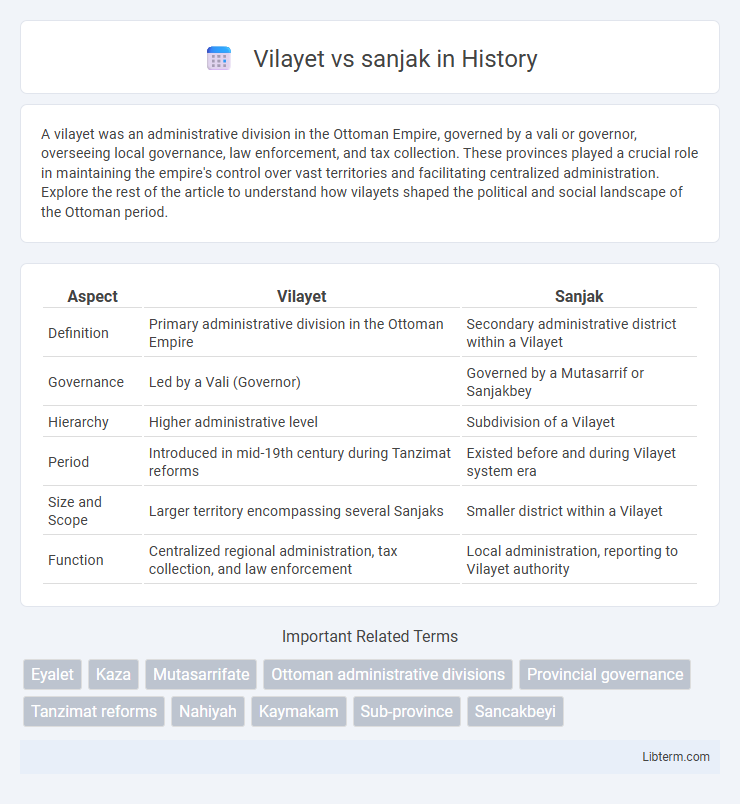A vilayet was an administrative division in the Ottoman Empire, governed by a vali or governor, overseeing local governance, law enforcement, and tax collection. These provinces played a crucial role in maintaining the empire's control over vast territories and facilitating centralized administration. Explore the rest of the article to understand how vilayets shaped the political and social landscape of the Ottoman period.
Table of Comparison
| Aspect | Vilayet | Sanjak |
|---|---|---|
| Definition | Primary administrative division in the Ottoman Empire | Secondary administrative district within a Vilayet |
| Governance | Led by a Vali (Governor) | Governed by a Mutasarrif or Sanjakbey |
| Hierarchy | Higher administrative level | Subdivision of a Vilayet |
| Period | Introduced in mid-19th century during Tanzimat reforms | Existed before and during Vilayet system era |
| Size and Scope | Larger territory encompassing several Sanjaks | Smaller district within a Vilayet |
| Function | Centralized regional administration, tax collection, and law enforcement | Local administration, reporting to Vilayet authority |
Introduction to Ottoman Administrative Divisions
Vilayets and sanjaks were key administrative divisions in the Ottoman Empire, with vilayets serving as large provinces governed by a vali, while sanjaks were smaller districts within vilayets overseen by a sanjak-bey. The vilayet system was formalized during the Tanzimat reforms in the 19th century to modernize and centralize administration, replacing the older eyalet structure. Sanjaks functioned as crucial subunits responsible for local governance, tax collection, and maintaining order within the larger vilayet framework.
Defining Vilayet: The Province Structure
A vilayet functioned as a major administrative province within the Ottoman Empire, governed by a vali who wielded significant authority over civil and military affairs. It was subdivided into sanjaks, which served as smaller districts managed by a sanjakbey, focusing on localized governance and tax collection. The vilayet structure allowed efficient central control while accommodating regional administrative needs, marking a crucial evolution from the earlier eyalet system.
Understanding Sanjak: The District Level
A sanjak refers to an administrative district within the Ottoman Empire, functioning under the larger vilayet provincial structure to facilitate local governance and tax collection. Each sanjak was headed by a sanjak-bey, responsible for maintaining law and order and implementing imperial policies at the district level. This subdivision enabled the Ottoman administration to exert control and efficiently manage diverse territories by delegating authority from the vilayet to more localized governance units.
Historical Evolution of Vilayet and Sanjak
The vilayet and sanjak were key administrative divisions in the Ottoman Empire, with the vilayet system introduced in the mid-19th century Tanzimat reforms to centralize and modernize governance. Vilayets were larger provinces governed by a vali, overseeing multiple sanjaks, which were smaller districts led by a mutasarrif. This hierarchical structure replaced the earlier, more autonomous eyalet system, aiming to streamline administration and enhance state control across diverse regions.
Governance and Leadership: Valis vs. Sanjak-beys
Vilayets were large administrative regions in the Ottoman Empire governed by Valis, who held extensive military and civil authority, acting as the Sultan's chief representative. Sanjaks, smaller subdivisions within Vilayets, were overseen by Sanjak-beys responsible for local law enforcement, tax collection, and maintaining order under the Vali's supervision. The governance structure emphasized centralized control through Valis while allowing Sanjak-beys limited autonomy in regional administration.
Administrative Functions: Vilayet vs. Sanjak
Vilayet functioned as a primary administrative division in the Ottoman Empire, overseeing multiple sanjaks within its jurisdiction and managing broader governance tasks such as tax collection, law enforcement, and coordination of local officials. Sanjak served as a subordinate district within a vilayet, responsible for more localized administration, including maintaining public order, local taxation, and implementation of policies dictated by the vilayet authorities. The vilayet governor (vali) held greater authority over military and civil administration, while sanjakbeys managed day-to-day administrative duties at the district level, ensuring efficient governance throughout the empire.
Geographic Scope and Population Differences
Vilayets were larger administrative divisions in the Ottoman Empire, encompassing multiple sanjaks, which were smaller districts within a vilayet. Vilayets covered broader geographic areas and included diverse populations often ranging from hundreds of thousands to millions, while sanjaks had more localized populations typically from tens of thousands to several hundred thousand. The geographic scope of a vilayet could span vast regions with varied topography, whereas sanjaks were more compact and focused on specific towns or rural areas.
Role in Ottoman Bureaucracy and Taxation
Vilayets were large provincial units in the Ottoman administrative hierarchy, governed by a vali (governor) who oversaw taxation, law enforcement, and military conscription, ensuring centralized control over diverse regions. Sanjaks were sub-provincial districts within vilayets, administered by a mutasarrif, responsible for more localized tax collection and maintaining order, acting as intermediaries between village leaders and provincial authorities. The vilayet-sanajk structure facilitated efficient revenue extraction and bureaucratic governance by delineating responsibilities between central and regional officials.
Impacts on Modern Middle Eastern Borders
Vilayets and sanjaks were administrative divisions of the Ottoman Empire that influenced the territorial organization in the Middle East, shaping current national boundaries by delineating regions of governance. The vilayet system, established in the mid-19th century, centralized control by grouping several sanjaks under a governor, which affected the political and ethnic composition of future states such as Syria, Iraq, and Lebanon. The legacy of these Ottoman divisions contributed to boundary disputes and ethnic mosaic patterns in modern Middle Eastern countries, underlying many contemporary conflicts and border negotiations.
Conclusion: Legacy of Vilayet and Sanjak
The vilayet and sanjak systems established critical administrative frameworks in the Ottoman Empire, with vilayets serving as large provinces and sanjaks as their subdivisions, enabling efficient governance and tax collection. Their legacy persists in modern administrative divisions across former Ottoman territories, influencing contemporary regional management and local governance structures. This hierarchical model provided a blueprint for decentralization, balancing central authority with local control, which continues to inform administrative practices today.
Vilayet Infographic

 libterm.com
libterm.com